
Introduction
Drafted
Operation Torch
Conversation Part 1
Sicily
Conversation Part 2
Anzio
Breakout
France
Germany
Austria
![]()

Anzio to Rome: May - July 1944
The army at Anzio had hunkered down long enough. During the quiet period the big guns were secretly brought in and enough combat men and service troops were added to make a successful attempt to chase the Germans from southern Italy. On May 23, 1944, the move was made both at Anzio and Cassino. The big guns roared. The darkness at night was broken by their flashes to the point a paper could be read. Another weapon was added: all the spare .50 cal machine guns were quietly placed to spray a sector on the 3rd Division front. What a big rattle and bang several hundred of these big machines make when they are closely spaced and firing at once in a predetermined pattern. The main attack was made by the 3rd Division towards the town of Cisterna. By June 4th we were in Rome. The cost was 511 killed, 2,575 wounded and 215 missing.
I should now get to telling what happened to HB while we were breaking our beachhead bonds after more than four months.
Cisterna
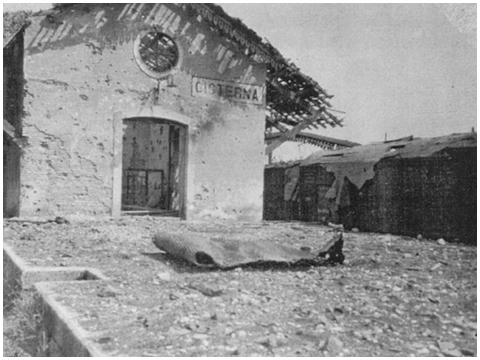
The railroad station at Cisterna.
Cisterna, the village that the Americans were desperately trying to take after D-day was now in the hands of our 3rd Division troops. The Germans did not give this town up without two days of house-to-house fighting at which time our infantry reached the center of town, which was the palazzo, the main square. Two hundred of the final garrison came out of hiding. When the great cellar below the palace was examined they found stinking heap of dead and wounded strewn all over with filth and dirty clothing. This great cellar provided the haven for the Germans during our bombardments. The statue on the great pedestal in the palazzo was still hanging in there.
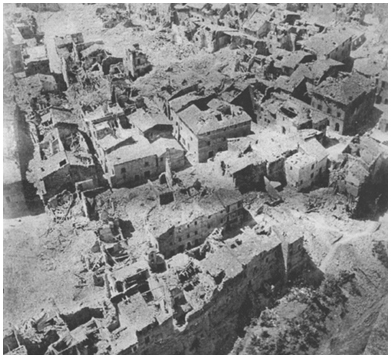
The Palazzo, the Rain Square. I bet this was a pretty place before the war.
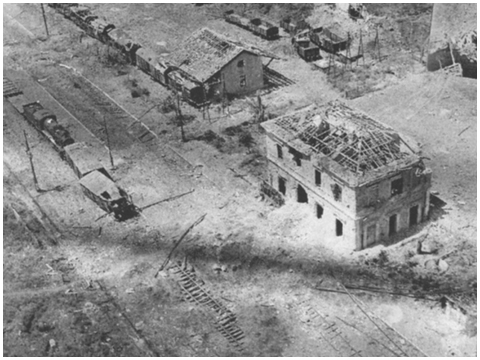
Cisterna, those people believed in living close together and one on top of the other.
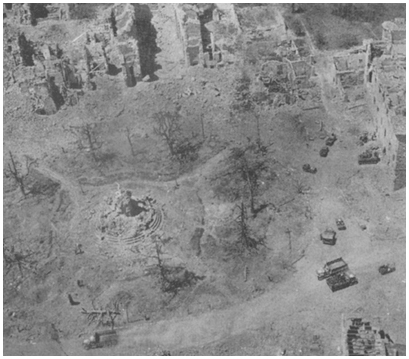
The railroad station, note that big bomb crater in front of the large building.
Cori
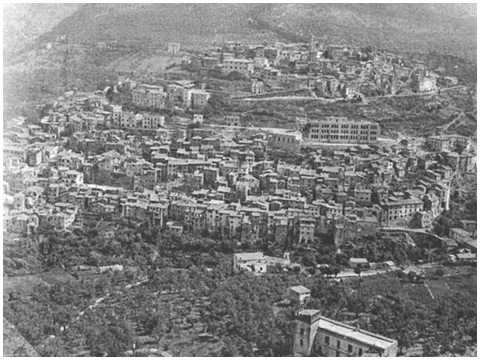
Cori, perched high upon the forward slopes of Monte Lepini, was an old Italian town built on high ground that overlooked the flat ground occupied by the beach head. The bell tower and the high building to the right and lower offered ideal observation pints. With the aid of telescopes and field glasses the Germans could observe targets and movement on our beach head and they could direct artillery fire and bombing at will. Note the two tanks parked in the opening at the lower middle of the photo. Also note the bell tower and what looks like a church that were bombed because they made good observation points.
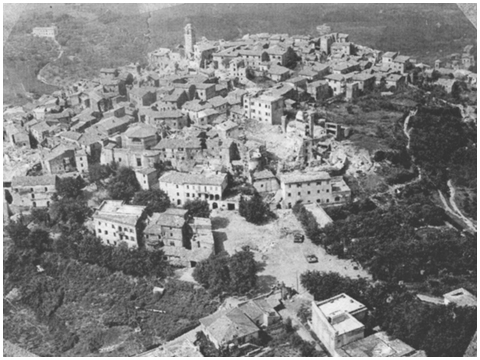
Cori, a better view. The town escaped with relatively little damage except those two observation towers. Note in the foreground there is an orchard of olive trees. Note Americans: Live on the unproductive land and farm the fertile lands.
Somebody said to take the 4X5 Graflex and pick up a guy from the PRO bunch at Division with the 3rd Recon Battle Patrol on a patrol in the mountains east of Cori. We had a jeep. Early in the morning the patrol met up with a small group of Germans in a wooded gulch on the mountain behind Cori. As a result a few shots were fired and the Germans gave up. One of the Germans was badly wounded and he was strapped on the hood of the jeep, and about twenty of thirty prisoners were captured. The patrol's lieutenant looked at us and said, I don't have anyone to take them back — so we were elected. First the German officer decided he wanted to ride in the jeep with the PRO guy. A bit of prodding with my carbine convinced him otherwise and he accepted the position of lead man. We went down the road strewn with German rifles, hand grenades, and the goodies of a fine fight — on to Cori and a PW cage. We picked up a dozen or more POWS on the way. No photos were taken as we were too busy doing the niceties of war.
After Cori things are now vague, but I do remember a few things. We, PRO and I headed back up the mountain with people and trucks bumper to bumper on their way over the mountain to Highway 6 toward Rome.
We had stopped at a curve in the road where a small quarry had been, and the Germans had used the quarry to set up a self-propelled artillery piece. Everything was at a standstill awaiting the traffic to move. The infantry troops were walking along the edges of the road. The weather was warm and clear.
Looking up I saw a couple of our fighter planes overheard. The stars on their wings were plainly visible, and the next instant bombs were dropped from one of the planes. A few seconds later the second plane unloaded its bombs. I don't know how close I was from the bombs that exploded near me, but I would guess within about a hundred feet or so. I was under that German self propelled gun.
You can imagine the damage and the casualties caused. We later learned the pilots were the famous black fighter squadron at Bani, Italy, were to blame. Four months of hell on the beach and have this happen! Nobody said war was nice.
The Lull Before the Bombs
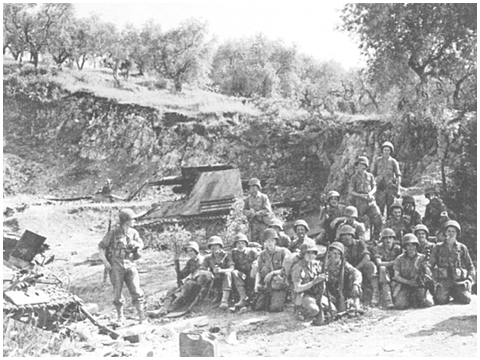
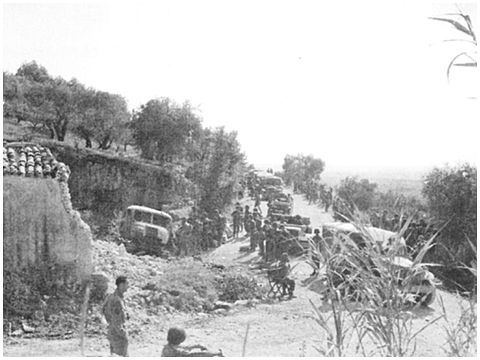
These photos were taken on the pass on the road between Cori and Valmontore. The 3rd Division was on the move trucks were bumper to bumper and the infantry was walking on the edges of the road.. At this moment movement was held up for some reason. I thought this was a good opportunity to get a few photos. The Germans used this quarry for gun emplacements. A few moments after I had taken these photos our P-51s dropped their bombs in the area. One of the bombs exploded just off the lower edge of the road shown in the top photo. I and a number of other guys crawled under that self-propelled gun shown in the lower photo. Note the German rifle leaning against the track of the other gun. The gas or water can at the foreground is German. We put those cans to good use. The moral of this is "Look before you shoot." Those stars on those trucks were visible to those pilots.
That evening trying to find a ride back or wherevers the Signal Co. had stopped. I was at a crossroad west of Cisterna and some infantry guys told me that this was where the Rangers had been ambushed, See page 15. The dead were still lying where they lost their lines. I photographed several of these heroes. They fell in no man's land and were still there four months later. Never send infantry against tanks unless they have tank protection. We did not know the strength of the Germans prior to this attack.
I finally found my company and my bed although German Strike planes bombed the area that night and scattered mud on it.
Rome
On to Bella Roma the next day, but on the way I found two of our company Second Lieutenant James Kemp and his driver Pvt Robert McGuire. They were looking for a place to set up a communication center and a German Anti-tank shell hit their jeep dead center through the radiator, killing both. Someone had removed the bodies and laid them side by side on the embankment by the road, and covered them with civilian blankets and the Italians had picked flowers and placed them on their bodies. The big man on the left is Lt. Kemp.
While held up by a roadblack, a group of Italians grouped along the road embankment became excited and were seeking cover because they had seen a couple of German tanks in a field about 1/3 mile away. I climbed the bank the tanks were milling about. Even though there were ten or so of our tanks bumper to bumper on the road they were all headed toward Rome. They would have been sitting ducks if the German tanks had chose to engage. I think they were on a look-see mission. They soon disappeared in the woods beyond. On to Rome.
While held up a the roadblock on the outskirts of Rome a couple of Italians in the marrying mood and their entourage had to abide until it was cleared then on to Rome.
We had nine days in Rome, living at the University of Rome, no clean sheets, no maid service but nobody was trying to kill us. I spent most of the time in the darkroom processing photos.
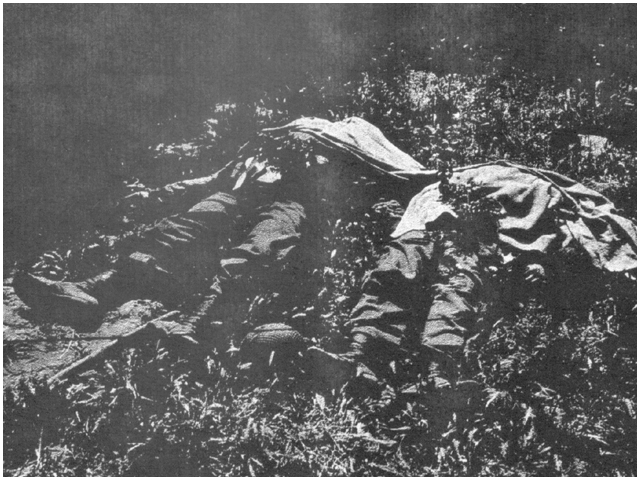
I suspected the worst when I saw the Third Signal jeep on the road south of Rome with a shell hole through the radiator. Then somebody said that two soldiers were dead on the embankment. I examined them and found they were Lt. James Kemp and his driver Pvt. Robert Maguire from the 3rd Signal Co.. Lt. Kemp was an enlisted man who had been awarded a battlefield commission. The Italians had covered their faces with a blanket and had placed bouquets of native flowers on their bodies. The men were scouting for a command post and laying wire when they ran into a German roadblock on Highway 6 south of Rome.
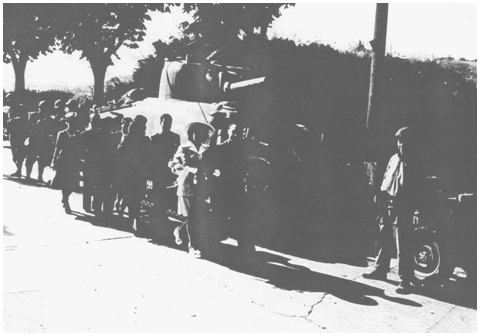
This young couple on their way into Rome to be married seemed to be very happy, which they had the right to be, because they had been freed of Hitler's tyranny. The entourage also were thinking "what a happy day!" June 4th, 1944. Photo by Nickelson.
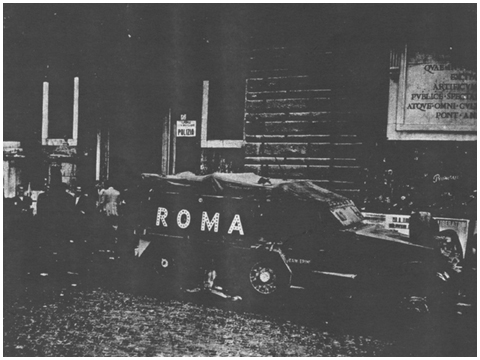
Tangerine the private limo furnished to General Robert T. Fredrick, commander of the Special Forces. The photo was taken at the Roma polizia station. Do you suppose that the general rode in the overstuffed chair on the hood? This may be a good place to state that General Fredrick had been wounded several times and had been awarded the Distinguished Service Cross two times.
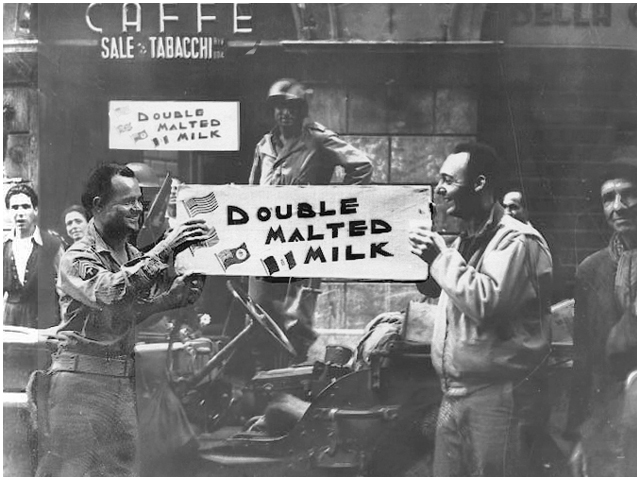
That Caffe owner must have been one of the many Americans that Mussolini would not let return to America. This man thought an appropriate welcome to the liberators would be a double malted milk. Jack Cole and Pop Heller toast the old boy's good intentions. Photo by HB Nickelson, June 1944 Rome.
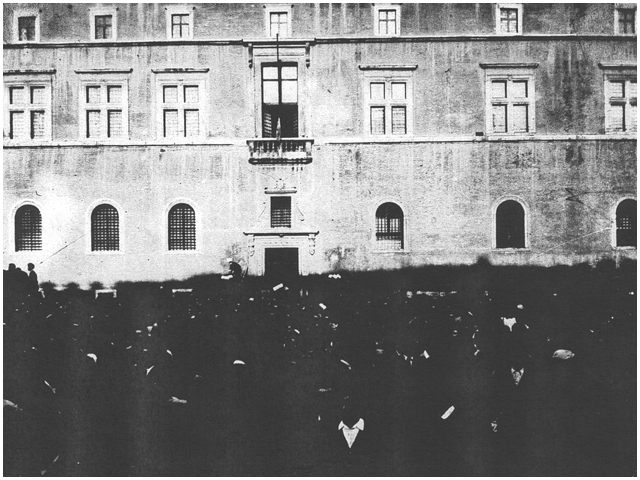
This is Mussolini's famous window where he gave many speeches promoting his great deals to the Italian people. The crowds came to celebrate the liberation of their beloved city. Note the almost lack of women and the men are dressed in suits and white shirts. Photo by HB Nickelson June 1944, Rome.
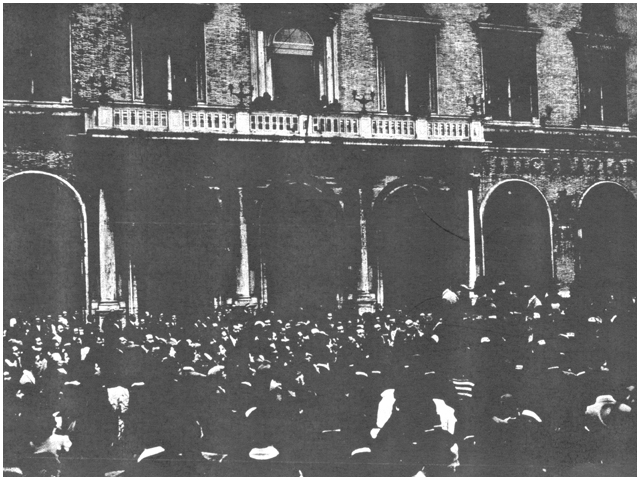
Thousands of people came out to welcome the change of their lives; they now had a chance to say how they would live without the threats of life or death. These people were not like the French when their towns were liberated. The French waved flats; there were many women, and much exuberation. The Romans showed relief and like they all were at a funeral, penance. June 1944 Romse. We also have to remember these people were very hungry. You don't see any fat men. Note the men on the right of the photo with the white bands on their arms. I believe they were partisans. Partisans were very active in Rome when it was liberated.
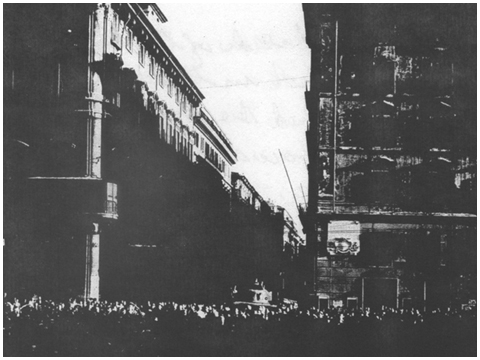
Another photo of the crowd that gathered on the main squares in Rome. Rome was declared an open city. Note the American tank down the street. On the left is a news outfit making newsreels of the Fall of Rome. Rome June 1944
Anzio Express - Anzio Annie
While at Rome I was picked to travel to Civitavecchia, north of Rome, to photograph the 280 mm railway gun the Germans used to harass the ships unloading in the bay and the troops on the beachhead. The Germans would fire this large artillery gun, then haul it back in a tunnel that was well camouflaged. The Air Force never did locate the piece. Before the break out they tried to get the gun to safety, but the Air Force located it in the rail yard of Civitavecchia and bombed it.
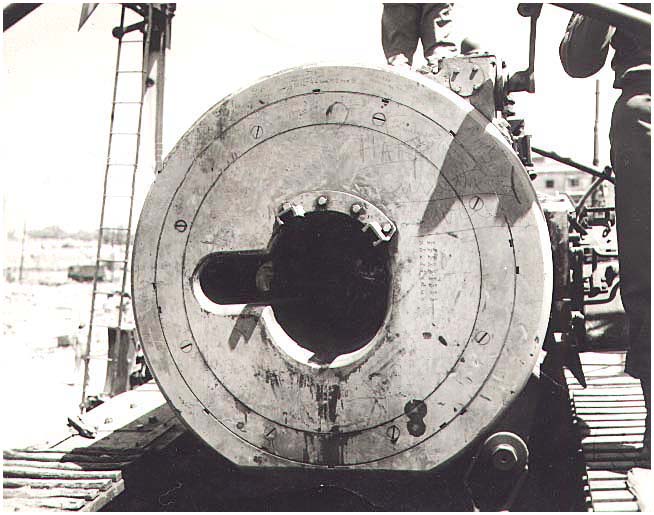
The breech block of Anzio Annie, the 280 man railroad gun the Germans used to harass the ships on the bay and the troops on the beachhead. Through the hole in the center the loaders pushed the projectile and loaded the powder, and their firing device. They then closed the locking device. When the gun fired from its hiding place somewhere in the Alban hills there was a discreet coughing sound, a pause while the projectile was on its way, then crump of the explosion. All the photos of this gun are by HB Nickelson taken June 1944 in Civitavecchia.
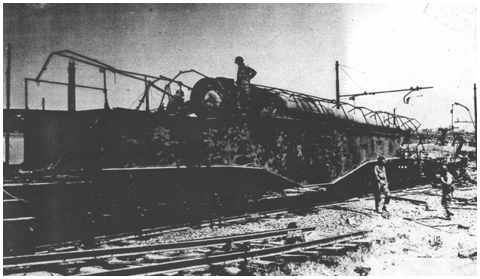
Having studied quite a bit of metallurgy in my college days, I can admire the German craftsmen that cast that gun barrel. Maybe that is why they called the gun Leopold. I also wonder how many Ferrari Autos were made from all the iron garbage left after these great battles.
The big gun's carriage sat on two rail trucks with a set of six rail wheels per truck. There was considerable more equipment for the gun on rail cars that had been damaged by our bombs.
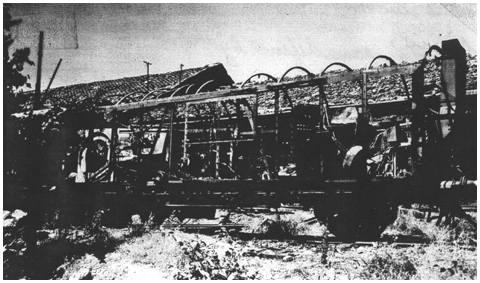
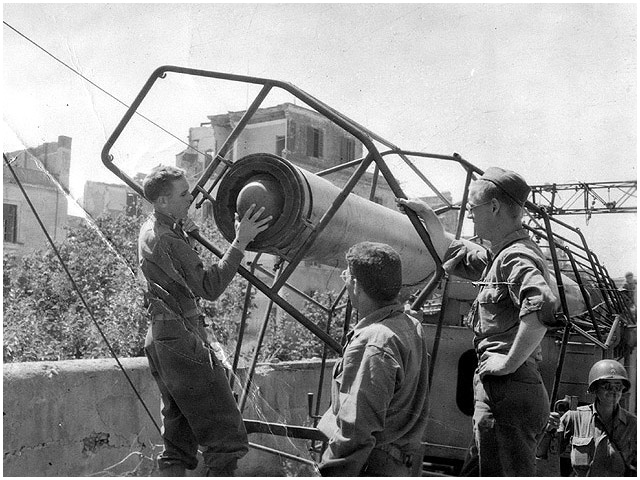
Some joker is trying his helmet on the end of that muzzle for size. The pipe frame was probably used to support camouflage. When the gun was fired form its hiding place in the Alban hills there was a discreet cough sound a pause while the projectile was on its way that sounded like a train going by then the crump of the explosion.
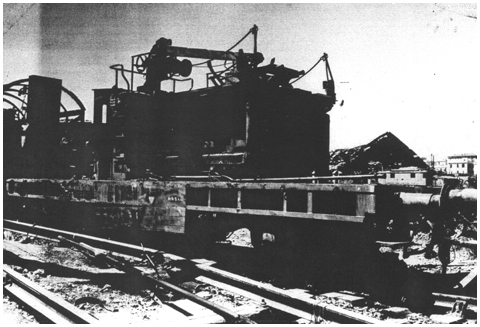
This is what looks like a control panel of some kind for Anzio Annie.
Howard B. Nickelson |
Introduction |
Drafted |
Operation Torch.
Conversation Part 1 |
Sicily |
Conversation Part 2 |
Anzio
Breakout |
France |
Germany |
Austria
Memoir appears by permission |